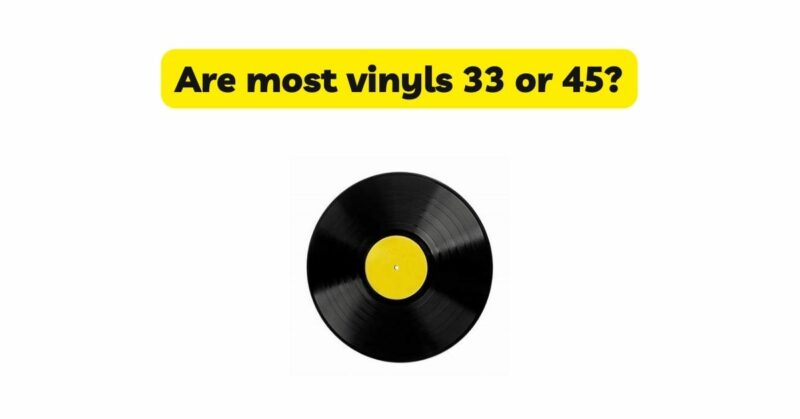Vinyl records have made a remarkable resurgence in recent years, captivating music enthusiasts with their warm, analog sound and unique listening experience. One key aspect of vinyl records is their rotational speed, which affects the playback duration and sound quality. In this article, we will delve into the prevalent speeds used in vinyl records: 33 RPM (revolutions per minute) and 45 RPM. We will explore their differences, historical context, and the factors that determine the choice of speed for vinyl records.
- The Rise of 33 RPM: The 33 RPM speed, also known as “LP” (long-play), gained prominence in the mid-20th century and became the standard speed for full-length albums. Introduced by Columbia Records in 1948, the 33 RPM format allowed for longer playtime per side, accommodating a higher amount of audio content. This speed became associated with 12-inch vinyl records, offering an immersive listening experience with extended playtime and improved sound fidelity.
- The Appeal of 45 RPM: The 45 RPM speed, also known as “singles,” emerged in the late 1940s and gained popularity as a format for individual songs. This speed was primarily used for 7-inch vinyl records, which were typically released as singles or promotional releases. The higher rotational speed of 45 RPM allowed for increased groove density, resulting in improved audio quality and louder playback.
- Sound Quality Considerations: The choice of speed, whether 33 RPM or 45 RPM, impacts the sound quality of vinyl records. Generally, 45 RPM records offer better audio fidelity, dynamic range, and clarity compared to 33 RPM records. The higher rotational speed allows for wider grooves and increased audio information per revolution. However, it’s worth noting that other factors, such as mastering, pressing quality, and the overall condition of the record, also significantly influence sound quality.
- Record Labels and Genre Influence: Record labels and musical genres often played a role in determining the speed at which vinyl records were released. Full-length albums, spanning various genres, were commonly pressed at 33 RPM due to the need for longer playtime. However, singles and shorter releases, particularly in genres like rock, pop, and R&B, were often pressed at 45 RPM to provide enhanced audio quality for individual songs. Therefore, the prevalence of 33 RPM or 45 RPM records can vary based on the genre and the specific release.
- Technological Advancements: Advancements in record player technology also played a part in determining the choice of speed for vinyl records. The introduction of automatic turntables and changers in the mid-20th century made it easier to switch between records, leading to an increased demand for 33 RPM records. Additionally, the adoption of jukeboxes in bars, clubs, and public spaces contributed to the popularity of 45 RPM singles, as the higher speed allowed for louder playback and better audio quality in noisy environments.
- Reissues and Contemporary Vinyl: In the modern vinyl resurgence, both 33 RPM and 45 RPM records are prevalent. Reissues of classic albums are often pressed at 33 RPM to preserve the original sound and provide a faithful reproduction of the analog experience. However, some audiophile editions and specialty releases are pressed at 45 RPM to offer enhanced sound quality and a premium listening experience. The choice between 33 RPM and 45 RPM for contemporary vinyl releases often depends on factors such as artist preference, label decisions, and intended target audience.
- Adaptability of Turntables: Modern turntables are generally designed to accommodate both 33 RPM and 45 RPM speeds, offering versatility for vinyl enthusiasts. Most turntablesare equipped with a switch or button that allows users to select the appropriate speed for the record being played. This adaptability ensures that vinyl collectors can enjoy a wide range of records regardless of the speed at which they were originally released.
Conclusion: In the vinyl world, both 33 RPM and 45 RPM records hold their place in terms of prevalence and significance. The choice between these speeds depends on various factors, including the intended playtime, genre, technological advancements, and historical context. While 33 RPM became the standard for full-length albums, offering extended playtime and immersive experiences, 45 RPM gained popularity as a format for singles, providing improved audio quality and louder playback.The sound quality of vinyl records is influenced by the speed at which they are played, with 45 RPM records generally offering better fidelity and dynamic range. However, it’s important to consider that sound quality is also influenced by other factors such as mastering, pressing quality, and the condition of the record itself.In contemporary vinyl releases, both 33 RPM and 45 RPM records are still prevalent, with the choice often determined by artist preferences, label decisions, and audiophile considerations. Modern turntables are designed to accommodate both speeds, allowing vinyl enthusiasts to enjoy a diverse range of records without any limitations.Ultimately, the choice between 33 RPM and 45 RPM records comes down to personal preference, the specific release, and the listening experience one seeks. Whether you prefer the immersive journey of a full-length album at 33 RPM or the punchy and vibrant sound of a single at 45 RPM, vinyl records offer a unique and captivating audio experience that continues to resonate with music enthusiasts worldwide.


